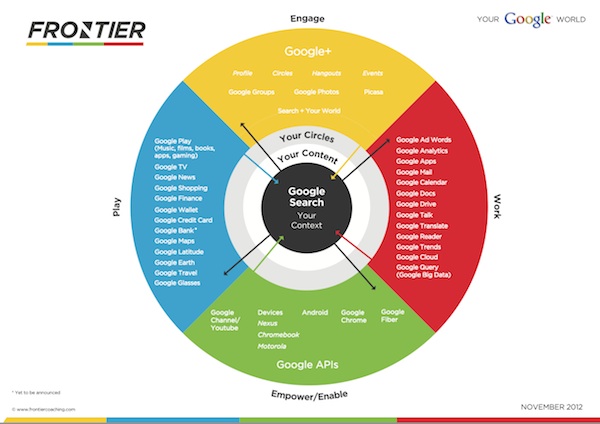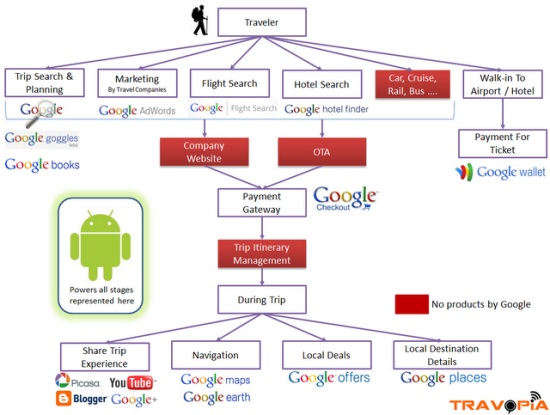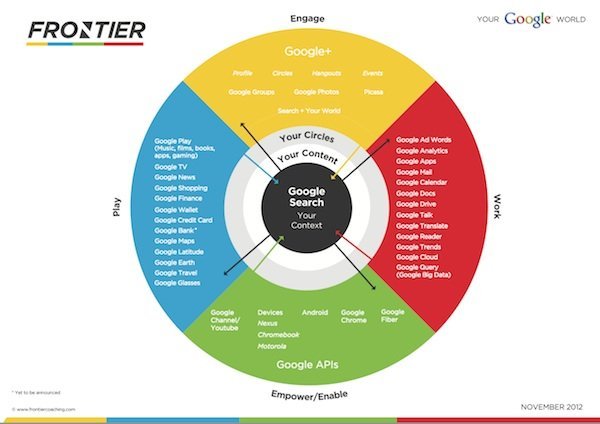Ever since Google was founded 15 years ago in 1998, the search company has grown and evolved into what it is today: a force to be reckoned with, an omnipresence that spans across online to mobile operating services. The folks at Frontier created an infographic showing the Google infrastructure today: did you know all these services and APIs existed? How many are you presently using?

Notice how Google+ is actually NOT listed as a stand-alone silo but rather stems from the heart of Google Search, the content you share (presumably through your blog, public social platforms and Google+) and the people you share it with, i.e. Your Circles. This says a lot, in particular to those nay-sayers of Google+ as “just another social media”.
TRAVEL IS MUCH MORE THAN GOOGLE TRAVEL
Now, if you look closely at this diagram, it would seem that travel is but a line in the overall Google equation. That ain’t necessarily so. Ever since 2010, when Google acquired ITA Software, a dominant online travel agency, many people in the travel industry have been waiting to see when and how Google would be making its big move into this sphere.
Truth is, Google has been moving slowly but surely towards online travel domination ever since that time. For example:
- Launch of its Google Hotel Finder functionality in July of 2011 to fight off meta-search engines such as Kayak which, incidentally, was acquired by Priceline last November.
- Around the same time, launch of Google Flight Search, entering the realm of flights and transportation. In 2012, this lead to the experimental Google Flight Explorer, a tool that seems interesting at first glance. But is it being used?
- Acquisition of Zagat, in september 2011. Zagat is best known for its restaurants reviews and comments, coming from over 350,000 ‘surveyors’ across North America and Europe, mostly.
- Acquisition of Frommers, in August 2012. This move was both a sign that Google was serious about travel and hospitality AND it wanted to position itself as the leader with quality content in this realm.
A growing travel web
These are just a few of the key elements that define the Google travel ecosystem as explained by the folks at Travopia:

In the above diagram, we can see where Google does not yet have a foothold, but as the speed things are evolving, I am not even sure this will still be accurate in 2013.
And it says nothing about how more and more people are getting savvy about online travel search and its influence in the travel purchase funnel. For more on this, read How Travelers Use Online Sources for Travel-Decision Making.
GOOGLE NOW AND THE POWER OF MOBILE
Yet, it is perhaps through its mobile application that Google will disrupt travel marketing in its biggest way, bringing in the ever-important notion of ‘real time’. One of the most underrated novelty of 2012 was Google Now, a mobile personal assistant that some compare to Apple’s Siri.
Among other things, Google Now addresses the “trip management” box in the above diagram by assisting with schedules, traffic itineraries and estimated times, and much more. It therefore encompasses your trip details, just like an application like Tripit would do, but with all the Google information related to maps, nearby restaurants, reviews or schedules it can tap into from its Google Earth, Google Maps, Zagat or Frommers content.
In fact, out of the 21 cards displayed by the application, there are eight that are directly related to the travel sphere. Namely:
Flights
Shows your flight schedules, gate changes, traffic itinerary and information to or from the airport
Hotels
Displays directions to your hotel upon arrival to your destination
Restaurants
Pops up reminders when you ought to leave in order to reach the restaurant based on real-time estimated travel time
Events
Provides information and details about an event, sends reminders if you purchased tickets
Public Transit
Displays next bus / train when you are at a bus / train station, gives estimated times of arrivals and details of itinerary
Places
Suggests nearby places of interest, bars and restaurants, based on your location
Nearby Attractions
Displays nearby attractions to visit [pulled from Zagat]
Nearby Photo spots
Displays nearby photo spots with estimated time to get there
What comes next
What’s next for Google in the travel vertical? With such an online domination, the one question that begs to be answered is probably: what if Google went into e-commerce? Or said differently: what if Google became transactional, as a full-fledged online travel agency? How disruptive would THAT be?
Not sure the regulators would allow this to begin with, but travel industry players need to take notice. Are you making the most of your presence online and via Google tools? Have you claimed your Place on Google? Are you monitoring reviews? Do you have a Google+ Brand Page? Do you have a Youtube dedicated channel or videos uploaded on the platform? How is your property or destination portrayed on Google Now?
I’d be interested to hear your feedback on this, so feel free to leave your comments in the section below.










Leave a Reply